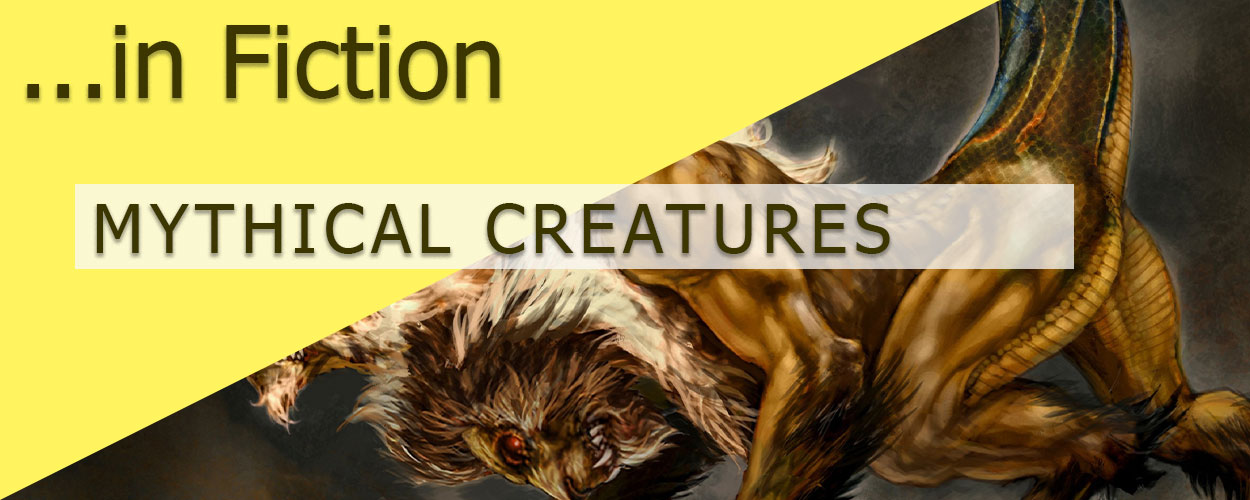

Posted: October 31, 2022
Fantasy, supernatural, and even science fiction almost always includes some form of mythical creature. Vampires, werewolves, mermaids, monsters, and more, any creature that can be found in mythology and folklore has and will be used in writing.
I think the most important thing to consider when you’re including mythical creatures in your work is to think about where those creatures come from. Does your story pull from a specific location or culture? Do you want to mix and match, or to invent your own creatures based loosely on existing ones? For example, Rick Riordan’s books [Related Review: Percy Jackson & the Olympians Book 1: The Lightning Thief], while all obviously based in different mythologies, dive deep into their individual cultures, and he reimagines the gods and monsters in his own way. He even includes a bit of overlap between cultures, thus hinting that all exist simultaneously, though it depends on your perspective what you see in the world (Greeks see Greek, Egyptians see Egyptian, Norse see Norse, etc.). He makes them each his own.
There is also a lot of overlap of creatures between cultures, so are you choosing to use the interpretation from one, from another, or make up one of your own from a combination? There are different versions of ghouls; of reanimated corpses; of wolf-men; of giant, hairy humanoids wandering the woods. There are mythical dogs, birds, fish, reptiles—more than you could imagine. They differ a lot based on the region they’re from; culture plays a huge role in the forms these creatures take.
Often, mythical creatures are combination creatures, half-human hybrids, animals that have been modified in some way (either with extra limbs or special powers), strange humanoids, or shapeshifters. Griffins, phoenixes, dragons, centaurs, mermaids, faeries, golems, dwarves, leprechauns, imps, ogres, harpies, winged lions, elves, onis, hellhounds, and Sleipnir the eight-legged horse are just a few I can name. The most well-known in the west come from Greek and Norse mythology, I think, and from the east, we know of quite a few from Chinese and Japanese culture as well, among others.
As for choosing what to use, I’ve seen it done both ways. I mentioned earlier that Riordan mostly focuses on a single mythology in his books, either Norse myths or Greek myths or Egyptian myths, and he gives quite a few well-known monsters for the heroes to fight and befriend, but he also includes obscure creatures that aren’t so well known. You see, there are entire species, but many of the myths include creatures that are one of a kind. The Minotaur, Medusa, Geryon, Typhon, Echidna, Cerberus, Orthrus, Scylla, Charybdis, Pegasus, Argus, the Chimera, and Chiron each has their own unique story, and while there are species as well—hellhounds, giants, cyclopes, centaurs, satyrs, nymphs, assorted demons and spirits—quite a few are the only ones like them because they were created or cursed by the gods. Some have been expanded into whole species like Pegasus and his children, the Pegasi, or gorgons from the original three gorgon sisters, Medusa, Stheno, and Euryale. Even hellhounds come from Cerberus, the three-headed dog which is son of Typhon.
There are also stories like Harry Potter, in which Rowling includes all sorts of inspiration for her work, basing House Elves mostly on (I think) Brownies—little creatures that come into your house and perform work in exchange for a saucer of cream. She includes werewolves, vampires, faeries, dragons, and other creatures like Fluffy the cerberus (made into a species instead of a single creature). She also invented quite a few of her own creatures that are based in myths but have been modified for uniqueness.
Cassandra Clare also writes with these creatures. The Nephilim, vampires, werewolves, warlocks, and faeries all come from angels or demons or both. [Related Review: The Mortal Instruments Book 1: City of Bones] They draw inspiration from quite a few different cultures, as they span the world and therefore are explained to be what’s “real” versus what the different cultures of the world have picked up on and incorporated into their myths.
I’ve seen this done as well. In which the author makes up their own interpretation which is seen as “correct” in their fictitious world, and that those who wrote the myths into their cultures have learned some but not all, such as in The Vampire Diaries, where werewolves are not in fact affected by silver, which is a lie made up by werewolves to protect themselves.
I’ve written a few stories with creatures such as these in them, and I’ve used pretty much all the methods. I’ve deep-dived into a single myth to ensure complete accuracy; I’ve blended cultures to give my creatures certain aspects; I’ve invented creatures all my own. The most important thing, though, is keeping them consistent throughout. I typically make lists and other documents to keep track of creature abilities and power-levels, but different practices work well for different people. Do whatever works best for you and your story.
Angels & Demons in Fiction
Deities in Fiction
Dragons in Fiction
Dwarves in Fiction
Dystopia in Fiction
Elves in Fiction
Fast Burn in Fiction
Heroes in Fiction
Love Triangles in Fiction
Magic in Fiction
Mythical Creatures in Fiction
Orcs in Fiction
Powers in Fiction
Pregnancy in Fiction
Propaganda in Fiction
Prophecies in Fiction
Romance in Fiction
Shapeshifters in Fiction
Slow Burn in Fiction
Vampires in Fiction
Vampires in Fiction II
Villains in Fiction
Werewolves in Fiction
Witches & Warlocks in Fiction
Percy Jackson & the Olympians Book 1: The Lightning Thief by Rick Riordan
*Unleashing Hell Book 1: Unleashing Hell by Kristen Johnson*
*The Robin Trilogy Book 1: Robin’s Flight by Breanne Leftwich*
*The Aodh Generations Book 1: The Gift of Marmidon by Tiffany M. Rhys*
The Ickabog by J.K. Rowling
Tigerpetal Press is a small book press dedicated to publishing local authors and poets.